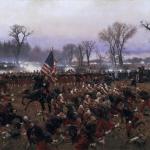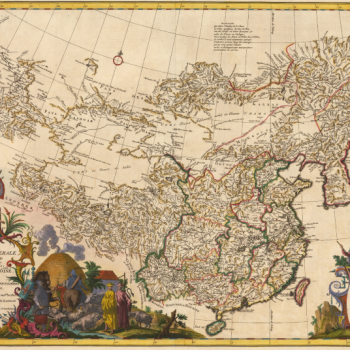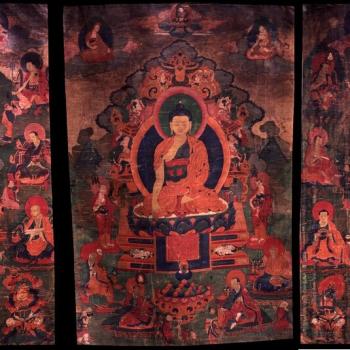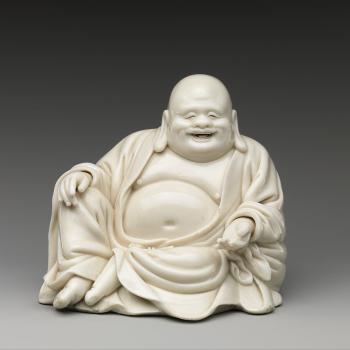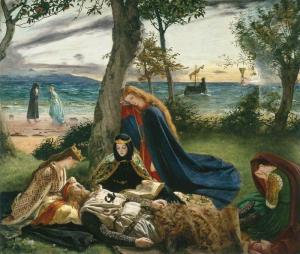
It is chiefly “Avilion” that has brought Bridges to the attention of researchers today. Lupack and Lupack offer a brief consideration to the poem in King Arthur in America, where they make the important connection between “Avilion” and Bridges’s allegiance to the Union: “Though no specific allusion is made to contemporary events, one cannot help but feel that the poem is really a comment on the events surrounding the Civil War,” (Lupack and Lupack 19-20). The Lupacks draw on Bridges’s adamantly pro-Union viewpoint in “The Question of the Day in 1860” to suggest that, in “Avilion,” “perhaps when Arthur says that the time is ripe for him to return ‘To lead the way to truth through seas of blood!’ it is the bloodshed of the Civil War and the truth of maintaining the Union that he is alluding” (20). Lupack and Lupack read the poem as a straightforward call for King Arthur to return to save the Union. They are certainly right to link Arthur’s return to the progress of the Union war effort, but they seem unaware of the fact that Bridges had grown increasingly disillusioned with the progress of the war and the Union cause by the time she wrote “Avilion.” But Bridges’s disillusionment is key to understanding the poem and when it is factored in, it becomes clear that there is far more going on in “Avilion” than the Lupacks suspect.
For the poem itself begins with a statement of her disillusionment. Bridges begins by remarking on her own lofty ambitions for her Arthurian cycle, saying that she hoped:
To set in common view, with Saxon words,
A living image of the ideal knight,
Lest men forget, amid these restless times
Of hollow shows and worshipping of gold,
That truth and pureness once were in the world” (“Avilion” ll. 14-18)
Bridges already shows a sense of disgust with her own times, calling them restless and stating that the “truth and pureness” that “once were in the world” have since gone out of it, to be replaced by “hollow shows and worshipping of gold.” Bridges thought that she could reverse this decline through her King Arthur poems—never let it be said that she did not have great ambitions—but she now recognizes that she has failed:
And what reward is mine for this my work?
Men will forget it in a little while,
And when this brain is dust, how few will care,
That once it throbb’d with inspiration’s heat! (ll. 39-42)
Bridges here accurately predicts the later obscurity that her work would fall into, suggesting that it was already being forgotten by the time she wrote “Avilion” in the 1860s. Bridges realizes that, once she is dead, “few will care” about the work she devoted her life too—she was, of course, right about this. Her ambition is clearly as strong as ever but she is clear-eyed about the fact that the public simply do not and will not care. In short, she knows that her efforts have come to nothing and Bridges is now sick of life. This is why she wishes, “Would I could go away from all the doubt, / The pain and turmoil of this weary life, / Into Avilion, where the good king went (ll. 43-45). The picture Bridges paints is one of complete disillusionment with her life, times, and writing career. It is only an escape from life, an escape into Avalon, that holds any promise for her now.
Within the poem at least, Bridges gets her wish. In a vision, she travels across the sea to Avalon. There, she encounters King Arthur and his court. That Bridges is not just disillusioned with her own circumstances but with the state of her country and the world is made clear when Arthur asks her, ““Do men still hope / that I will come again, as Merlin told, / To do my best to win for them the right?” (ll. 173-75). Bridges does not answer him directly but instead paints a drab picture of the state of the world in the nineteenth century: “I drew a picture of the times, / And how the nations groan’d because was found / No strong, true leader pure in life and aim” (ll. 176-78). This statement drips with despair; Bridges believes that nowhere on earth in her own time is there a good leader or anyone to trust with government. Whole nations are suffering because of this and there is no hope to be found. This, like “After the Battle,” feels like a grim commentary on her own statements in “The Question of the Day in 1860.” There, Bridges had said that if the Union failed, all hope would die out around the world and all peoples would suffer. Now, hope has died out in the world and there is only suffering. Once again, Bridges demonstrates that her dark warning has come true and the millennialist potential of the United States has come to nothing.
This is enough to link “Avilion” to “The Question of the Day” and surmise that Bridges is thinking of the troubles of the Union cause and the American nation more broadly as she is writing. But there is something else, in the statement quoted above and in “Avilion” more generally, that points in this direction. Crucially, Bridges tells Arthur that “the nations groan’d.” She does not give him an update on Britain’s situation but instead tells him of “the nations,” suggesting that Arthur’s concerns are international rather than insular. Bridges casts Arthur as a global figure, concerned with the plight of humanity as a whole rather than a single nation. Arthur is troubled by this news on the state of the world and withdraws from the conversation. After Bridges chats with Guinevere and Lancelot for a while, Arthur returns and announces:
The time at last is ripe!
I will go back again! The people need
A chief whose soul knows glories that will lift
His deeds and motive o’er all petty price.
I wore a crown before, and felt its thorns;
And I have known since what it is to live
In heavens won by duty: so I go
To lead the way to truth through seas of blood! (ll. 208-215)
It is clear from what Arthur says that he has heard what Bridges said before and that it is the chief factor in his decision to return to the world. Bridges had said the nations lacked a “strong, true leader.” Arthur says that he will be that the leader, the “chief” that “[t]he people need.” In his affirmative answer to Bridges’s veiled suggestion that he return to save all the nations, not just Britain, Arthur reveals that she was right to see him as an international figure. He is concerned with the well-being of people everywhere and his saving mission will have no national boundaries. By vowing to return, he becomes a figure of hope for all the world, promising all the nations and all peoples that a better day is coming.
In fact, he fulfills the role that Bridges had claimed that the United States itself did in “The Question of the Day in 1860.” There, Bridges had said that the United States served as the source of hope for all oppressed peoples around the world. Now, in “Avilion,” Arthur has become that hope. Bridges has essentially transferred the role of America in its own nationalist millennialism onto a single individual, Arthur. Her fantasy from “The Question of the Day in 1860” has become a reality, at least inside the poem itself. The “mighty dead” will indeed return to save the millennialist hope that America had embodied. Now, however, Bridges has refined that fantasy from a whole generation of American patriots down to a single long-deceased hero, one who is not even American. The millennialist hope has also been refined. It too is no longer specifically American, no longer necessarily tied to the United States. The turmoil of the American Civil War is certainly a large part of what Bridges is alluding to when she tells Arthur of the poor state of things in the modern world. But the coming hope has largely ceased to dwell in America and come to rest on the figure of King Arthur instead.
“Avilion” is a remarkable poem in many respects. Only a few authors have dared to extend Arthur’s story beyond his departure and actually ponder the nature of his return at length. And of these, surely no other one has been so bold as to make themselves the catalyst of Arthur’s return. And yet, the transfer of America’s millennialist ambitions to Arthur is perhaps the most remarkable thing about the poem. It represents the culmination of Bridges’s wrestling with the ideology of nationalist millennialism, of her loss of faith in America’s ability to fulfill the millennial promise and her need to still believe in the promise itself. She had needed a solution to her struggle that would allow her to still hold to millennialist hope in the face of national difficulties and, in “Avilion,” she managed to create just such a solution, however bizarre it must otherwise seem.
For make no mistake, Arthur’s mission is indeed a millennialist one. Sallie Bridges has fully imbibed the view of Arthur as great world-savior and harbinger of the millennial age found in “The Epic” and other Tennyson poems. And this time, unlike in her earlier efforts, Bridges is more than willing to admit the influence. Not only does she name her poem “Avilion” after Tennyson’s own preferred spelling of Avalon but she even uses four lines from “Morte d’Arthur”—the poem originally conjoined with “The Epic”—as an epithet at the beginning of her poem. Even so, given that Bridges adheres to a conventional form of Christianity rather than Tennyson’s nebulous spiritual ideas, she is very aware of the fact that it is Christ who must rule the millennial kingdom and it is Christ who must be at the center of the world’s great spiritual transformation. However, she still wants to place Arthur at the center of the coming global rebirth. This creates a dilemma for her. Her resolution to it is quite shocking, given just how conventional her piety had seemed up to this point. What Tennyson had done only implicitly, through veiled suggestion, Bridges ends up doing much more openly and explicitly. Faced with the need to reconcile their millennial roles, Bridges simply chooses to identify Arthur with Christ.
There is really nothing subtle about this. From the moment that Bridges sets out on her journey to Avalon, it is clear that she is not merely travelling to some fairy isle in the Atlantic. She is crossing over into the realm of the dead. And not just any realm of the dead, but the Heaven of Christianity. The first person she meets on this journey is her boatman. This figure reminds Bridges of Charon; she tries to offer it a coin, which it refuses quite dramatically: “He gazed at it in wonder, curved his arm, / And dropp’d it in the waves” (ll. 68-69). However, Bridges’s description of it wearing “white garb stirless as a statue’s robe, / That seem’d to sweep adown o’er folded wings” (ll. 56-57), suggests that the figure is actually an angel. When Bridges approaches the isle, she feels the return of a long-lost health and vigor, “My youth and hope came back to me once more” (l. 85), and experiences a moment of mystical insight, ““Deep, secret meanings dawn’d upon my brain / That had been dull’d with dust, but in this clime, / Saw the hidden truth,” (ll. 89-91). Bridges comes to instantly understand both the truth of God’s existence and the reason for evil; regrettably, on the latter point, her readers do not get to share in the joy of solving one of theology’s most intractable problems, for “I may not show / What grand significance e’en evil took!” (l. 95-96). Regardless, a return to youth and health and the revelation of God’s mysteries are two things that are popularly supposed to happen in Heaven. That Bridges has them happen in Avalon makes the identification of the two quite clear, as does the fact that “there was nothing of the sadness here / That stole through all the Nature I had known” (ll. 146-47). There is no misery and suffering in Avalon, only a spiritual joy “such as comes / To human hearts in love’s divinest hour” (ll. 141-142), reflecting the state of perpetual bliss and spiritual illumination that is the defining characteristic of the Christian Heaven.
Just as Heaven is the afterlife destination for redeemed and faithful Christians, Bridges finds that the isle is populated by the righteous dead. When Bridges encounters her long-dead beloved, he asks her, “Was it not worth the tears we shed on earth / To love forever in Avilion thus?” (ll. 118-19), expressing the common Christian theme than sufferings in this life will be repaid by bliss in Heaven. In many respects, these encounters with the dead feel like wish-fulfillment for Bridges. This is particularly apparent when Arthur calls a council to discuss his return to the world of the living. Not only do his knights and Guinevere show up, but also an odd and eclectic assortment of just about every historical individual Bridges had any admiration for. There is perhaps no other poem in which readers are treated to the curious sight of British literary luminaries striding hand in hand with Ancient Greek poets while Joan of Arc brings up the rear.
But this is not simply a new form of the Isles of the Blessed, where the revered figures of the past gather without regard for religious sensibilities. The figures in the procession, even pagans, are described as being full of Christian illumination. In both traditional Christian thought and great works such as Dante’s Paradiso, the chief activity in Heaven is contemplation of God’s nature. This is what everyone in Avalon, Christian and pagan, is chiefly engaged with. Lancelot, of all people, is so enraptured by the beatific vision that he no longer feels attracted to Guinevere, instead exclaiming, “My God! my God! I love but Thee, my God!” (l. 205). In addition, the procession of righteous dead includes the “martyrs who had mix’d / The last triumphant strains of holy lives / With hatred’s incense of ascending flames” (ll. 344-46). The presence of the holy martyrs of the faith in Avalon and at Arthur’s council not only confirms that this is the Christian Heaven but, as an added bonus, also recalls “the souls of those who had been slaughtered for God’s word and for the testimony they bore” (Rev 6.9) in the Book of Revelation. Of course, in Revelation, the martyrs ask, “How long, sovereign Lord, holy and true, before you will vindicate us and avenge our death on the inhabitants of the earth?” (Rev. 10). The martyrs of “Avilion” voice no such request. But their mere presence makes Arthur’s council resemble God’s own in Heaven in Revelation, adding a suitably apocalyptic air to the proceedings.
Thus, when Arthur calls Avalon Heaven—twice, once in the line about “heavens won by duty” quoted above and then when he vows to go back to earth alone because “my work / Needs not that more to be banish’d from their heaven!” (ll. 397-98)—the confirmation is nice but hardly needed. Bridges clearly intends her readers to see Avalon and Heaven as the same place. But if Avalon is Heaven, what does that make Arthur as the ruler of Avalon? The obvious answer, however blasphemous it must seem, would be God. And since God the Father is a distinct, albeit distant, presence in the poem, Arthur must instead be identified with Christ. This is no mere logical leap, for Bridges insists upon the identification throughout the poem, beginning with the moment when Arthur announces his decision to return to the world. That passage was quoted above and alert readers no doubt picked up on the lines, “I wore a crown before, and felt its thorns; / And I have known since what it is to live / In heavens won by duty” (ll. 212-14). This is an obvious allusion to Christ’s earthly career, with the wearing of the crown of thorns and the subsequent ascension to Heaven. But Arthur is obviously referring to himself when he says these things, implying that Bridges—and by extension, her readers—should think of him in Christlike terms. While Arthur is not saying that he experienced the events of Christ’s life as depicted in the Bible, the fact that he describes the events of his own life in the exact same terms suggests that he is aware of a basic equivalence, and even a sense of shared identity, between himself and Christ.
Bridges continues throughout the poem to suggest that Christ is Arthur’s true identity. At several points his words mirror those spoken by Jesus in the Gospels. After announcing his decision to leave for the mortal world, Arthur exhorts Guinevere, “Pray to God, / Who sends me on His errand, that His love / Shall compass me about until the end” (“Avilion” ll. 219-21), a direct echo of Christ’s famous words in the Gospel of John, “I seek to do not my own will, but the will of him who sent me” (John 5:30). And later, when Arthur’s retainers attempt to join him on his journey, he tells them, “Nay, nay, dear friends! It is the will of God!” (l. 399), in an allusion to Jesus’s own vow in Gethsemane to fulfill God’s will despite his own suffering, “Yet not my will but yours be done” (Luke 22.8). Furthermore, when Arthur utters the name of God in this latter moment, it has a special effect, “And at the sacred Name all bow’d their heads and let him pass” (ll. 400-01), which implies that Arthur shares a special connection with God like the one between God the Father and Christ.
There is also the matter of the length of Arthur’s sojourn on earth. When Guinevere sheds tears over his decision to leave, Arthur comforts her by stating, “’Twill not be long to wait: you know, beloved, / A thousand years in His sight are a day!” (ll. 222-23). This line originates with the 90th Psalm but, in this form, it is quoted from 2 Peter, “in the lord’s sight one day is like a thousand years and a thousand years like one day” (2 Pet. 3:8). In 2 Peter, the line is used to assure believers that Christ’s Second Coming is still going to happen, despite having taken much longer than the early Church expected. By associating the line instead with Arthur’s own second coming, Bridges implies that his return and Christ’s are the same event and that they themselves are the same individual. Similarly, if the line is taken at face-value, Arthur seems to be telling Guinevere that he will be in the mortal world for the span of one-thousand years. This would mean that Arthur’s coming reign is exactly the same length as Christ’s own future reign on earth and has exactly the same characteristics. The inescapable conclusion is that they are the same millennial reign and that, in Bridges’s mind at least, Arthur and Christ are the same divine individual.
It is the poem’s final lines that clinch this identification of Arthur’s coming reign with Christ’s own and of Arthur himself with Christ. As Bridges watches Arthur depart Avalon in a boat and begin sailing back to the mortal world, the vision suddenly vanishes. Bridges ends the poem by stating, “I found myself once more within this world, / On which the shades have gather’d into night / And mid the throng that wait the coming King!” (ll. 410-12). This is a surprisingly apocalyptic moment that could easily be describing Christ’s future advent. The “shades have gather’d into night” over the world, the sun has set upon the world’s day, and all that is left is night and the coming end of the world. At the end, the “coming King” will appear and the best that believers such as Bridges can do is await his coming. This all brings to mind the apocalyptic narratives of the New Testament, with the world falling into ever-increasing turmoil until Christ finally appears in the clouds to end historical time and usher in the “new heavens and a new earth.” However, from reading the poem to this point, Bridges’s audience knows that she is not referring to Christ here, but to Arthur. Arthur is the king who shall reign at the end of the world, the king who shall establish universal justice and peace, the king who shall rule for a thousand years. By the end of “Avilion,” he has completely taken over Christ’s role as humanity’s apocalyptic savior and the future ruler of God’s kingdom on earth.
Again, however, given the resolute—if eccentric—Christianity on display in the rest of the poem, it should not be assumed that Bridges intends to displace Christ with Arthur. Rather, when the extensive parallels between the two are taken into account, the only possible conclusion is that Bridges intends her readers to see Arthur and Christ as the same individual. Arthur is Christ in a more royal and militaristic guise, a warlike Christ who will be more at home “lead[ing] the way to truth through seas of blood” than the peaceful Jesus of Nazareth seen in the Gospels. The Book of Revelation certainly called for such a militant form of Christ in the last days and it was Tennyson who first tentatively and furtively suggested that Arthur and Christ might be identified as two manifestations of the same cosmic force. But Bridges goes further than either by explicitly identifying Arthur not just with Jesus of Nazareth but with the belligerent, sword-wielding Christ of the Book of Revelation.
The uneasy impulse to equate Arthur with Christ, seen since the beginning of the return myth and previously defused or accommodated by the Last Emperor narrative, has now reached its final fulfillment in Bridges’s open identification of the two. It is remarkable that Bridges, otherwise so bound by the conventional thought of her age, got this far. It is even more remarkable that the catalyst of this extraordinary vision was the American Civil War and Bridges’s need to redeem the central promise of American nationalist millennialism. When that promise could no longer confidently be located in the United States and the cause of an unshattered Union, Bridges went searching for a new source of millennialist hope. She could simply have found it were countless disillusioned Christians before her did, in a sharp rejection of the world in favor of Christ’s coming kingdom. To an extent, Bridges did embrace such an anti-worldly vision. But she did not give up on the world entirely. Instead, she turned back to the Arthurian stories that she had preoccupied herself with before the war began. Relying upon what Tennyson had done before her, Bridges used those stories to create a new source of hope, one that dwelt in an Arthur-Christ composite whose immanent coming would fulfill both the promise of Christ’s thousand-year rule and the longing for Arthur’s future return as part of a single world-redeeming millennial program.
It is an astonishing vision, all the more so because Bridges seems to truly believe it. There is no bracketing of the fantasy as there was in “The Question of the Day in 1860.” At the end of “Avilion,” Bridges places herself “mid the throng that wait the coming King” with no suggestion that there is any more realistic alternative that she can pursue. She had previously despaired of earthly life entirely and found peace only in the Heaven of Avalon. Thus, she sees no other solution than for that Heaven to come to earth; the Christ-Arthur figure is the only hope for sorting out the chaos of the Civil War and the wider turmoil in the world. Bridges seems deadly serious when she suggests that only this composite divinity can fulfill the millennial promise that America had once futilely laid claim to.
But what is even more astonishing is the fact that Bridges’s vision is not unique. Another poet, completely unaware of Bridges but also drawing on American millennialist self-regard and Tennyson’s Arthurian poetry, produced a vision of an Arthurian apocalypse that fundamentally agrees with Bridges on her most remarkable points. He also felt that the disappointments and failures of the Civil War would bring Arthur back into the world and he too identified Arthur with Christ. The chief difference is that Francis Orray Ticknor was a Confederate and it was the fall of the Confederacy, not its successes at making the war longer and bloodier, that he was reacting to. Despite having an opposing allegiance to Bridges, however, Ticknor came upon the same bizarre solution to America’s troubles as she did. The result was that the strange, extraordinary idea of a composite Christ-Arthur figure using America’s existential crisis as an excuse to establish his millennial reign on earth manifested itself not once but twice amidst the turmoil of the Civil War.
Works Cited
Bridges, Sallie. Marble Isle, Legends of the Round Table, and Other Poems. Philadelphia: J. B. Lippincott and Co., 1864. https://hdl.handle.net/2027/hvd.32044080898240. All of Bridges’s Arthurian poems can also be accessed as part of the University of Rochester’s Camelot Project.
Lupack, Alan and Lupack, Barbara Tepa. King Arthur in America. Cambridge: D. S. Brewer, 1999.
The Revelation of John. The Oxford Study Bible, edited by M. Jack Suggs, Katharin Doob Sakenfeld, and James R. Meuller. New York: Oxford University Press, 1992. 1556-1575.
The Second Letter of Peter. The Oxford Study Bible, edited by M. Jack Suggs, Katharin Doob Sakenfeld, and James R. Meuller. New York: Oxford University Press, 1992. 1544-1546.

